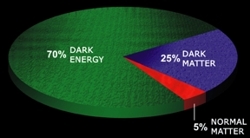JDEM
Take all the stars, all the planets and everything we can see and detect with telescopes and add them all up. That total will represent only four percent of the universe. If the universe came with a list of ingredients, the ordinary atoms that make up stars, trees and animals would be at the bottom of the label, like some exotic spice. Nearly 25 percent of the universe takes the form of dark matter, a mysterious substance that seems to be intrinsically different from ordinary atoms. And the rest, a whopping 70 percent of the universe, is a mysterious quantity we call dark energy.
As a comparison, remember that about 70 percent of the Earth's surface is covered with water. Imagine not knowing what water is! That's the situation we're in with dark energy.
The observations that first led to this confusing situation were the observations of the velocities of distant supernovae. The key is that, as we look at supernovae far away, we are seeing them as they were long ago. The fact that they were moving away from us more slowly than expected showed that the expansion of the universe, instead of slowing due to gravity, was actually accelerating. No known component of the Universe could have caused this acceleration. Suggestions for unknown components have included a new kind of fluid, called "quintessence," an unexpected property of the vacuum of empty space, or a fundamental modification of Einstein's theory of gravity. Whatever the final explanation may be, it will revolutionize our understanding of the physics of the Universe.
The National Academy of Sciences has stated that the nature of dark energy is probably the most important question in astronomy today. It has been called the deepest mystery in physics, and its resolution is likely to greatly advance our understanding of matter, space, and time.
In response to recommendations by the National Academy of Sciences, NASA and the DOE spent several years working together to evaluate a possible future mission which would study the expansion history of the universe. However, a result of the 2010 Decadal report was that JDEM was not selected as one of the ranked recommendations. The new WFIRST Observatory was instead recommended to settle the essential questions in both dark energy and exoplanet research.
Last updated: June 6, 2012

